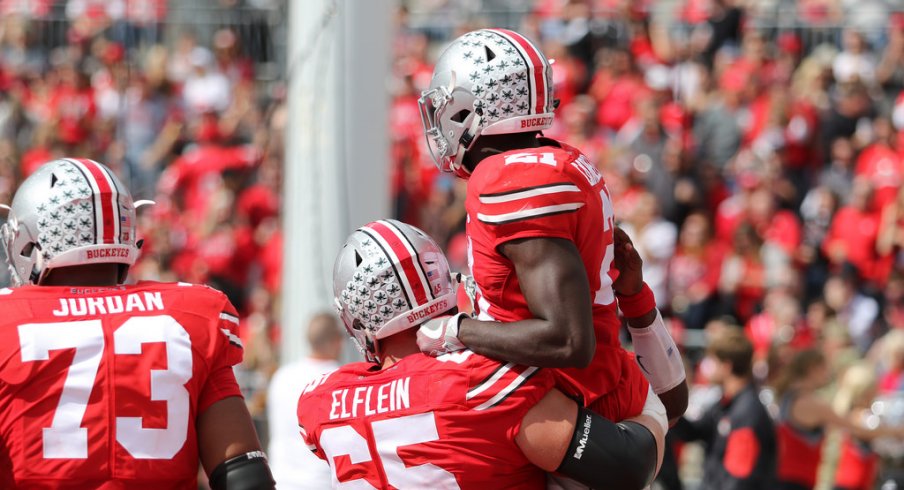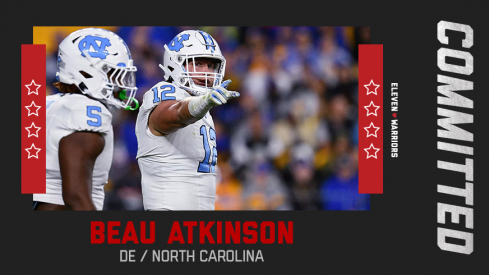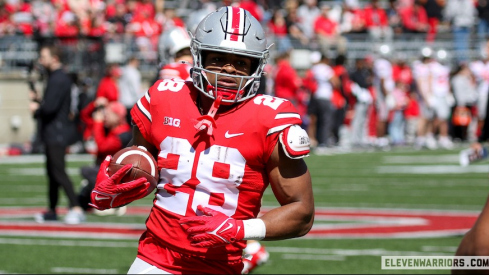After two years of watching opponents stack their defensive fronts with looks set to stymie the interior running game, Urban Meyer has finally decided to take things outside.
It obviously helps that his best player, Curtis Samuel, has the speed to exploit defenses both as a running back or receiver, but the 2016 Ohio State offense has embraced a philosophy quite different from the one we saw when Carlos Hyde or Ezekiel Elliott were taking handoffs in the Buckeye backfield.
Just as he had in the previous game against Oklahoma, Samuel kicked off the first Buckeye possession against Rutgers by taking back-to-back lead-sweeps around the outside, running the exact same play to each side and picking up a first down. While he took a break to catch his breath, tailback Mike Weber joined the fray, catching a swing pass and taking an outside handoff for a first down of his own. Within the first four plays, just as they had against the Sooners, play-caller Ed Warinner had made it clear that their primary plan was to attack the open field outside of the tackle box.
While the Buckeyes cruised to an easy 58-0 win in which they tallied 410 rushing yards against the Scarlet Knights, the more important takeaway was not the total number of yards, but rather how they got them. Much of what we saw was nothing new to close followers of the team, as each of the concepts shown on that first drive has long been part of Meyer's playbook. In addition, the Power-Read concept that was prominently on display and would eventually spring Weber to a 46-yard touchdown run in the second half is also one of the coach's favorites.
As expected, Chris Ash played the same, 4-3 Over front he installed in Columbus before the 2014 season, the same one we still see from the Buckeye defense today. Such a look should be susceptible to the inside running concepts like the 'Tight Zone' and 'Power-O' that Meyer long relied upon to open up lanes for Hyde, Elliott, and others. However, with Ash's 'Quarters' safeties undoubtedly looking to get involved in stopping the run, just as we've seen from Michigan State in the past, Meyer threw his former assistant a curveball.
Not only did Meyer, Warinner, and co-coordinator Tim Beck build the game plan for the Scarlet Knights around relatively basic outside runs, they added a strong dose of misdirection as well. On their second drive of the game, with Weber in the backfield and tight end Marcus Baugh in a 'Y-off' look, it certainly appeared as though we were about to see the common "Split-Zone" variation of the "Tight Zone," with Baugh coming across the formation to seal off the defensive end while Weber looks for a running lane inside.
What we got instead, was something quite different altogether:
After Samuel broke out for a 30-yard gain that caught nearly the entire Rutgers defense on their heels, the Buckeyes would reward Parris Campbell for all his hard work blocking and on special teams with an easy touchdown run off the same play in the second half. But while the base concept was the same, it came from a different formation the second time, marking a clear effort to disguise tendencies for any future opponents as they prepare to face the Ohio State offense.
Though the Spartans have given the Meyer the most trouble during his four seasons in Columbus, the move to proactively showcase a slightly different offensive philosophy is about more than just them now. Wisconsin's defense is one of the nation's best, built around a 3-4 scheme that features excellent outside linebackers. The Buckeyes can't simply let those players squeeze the inside running game when they face off in Madison in just under two weeks, instead forcing them to be wary of keeping outside contain.
Most importantly, though, this lateral philosophy with countless bells and whistles built on will keep a certain defense up north busy. While both teams still have to travel to East Lansing, and there are always unexpected slip-ups during conference play, it's hard not to look ahead to the regular season finale with the Wolverines as Ohio State's toughest remaining test.
The maize and blue defense has lived up to the preseason hype, stuffing opposing running games with a big, physical defensive line while shutting down aerial attacks with aggressive, man-to-man pass defense. Trying to impose an inside running game on its own would only play into the strengths of the Buckeyes' biggest rival.
Instead, showing that not only can they attack the edge aggressively, but that they can do so in countless ways, will make Mike Weber's job much easier when his team needs him to grind out a critical third-and-short in a critical late-November matchup.



